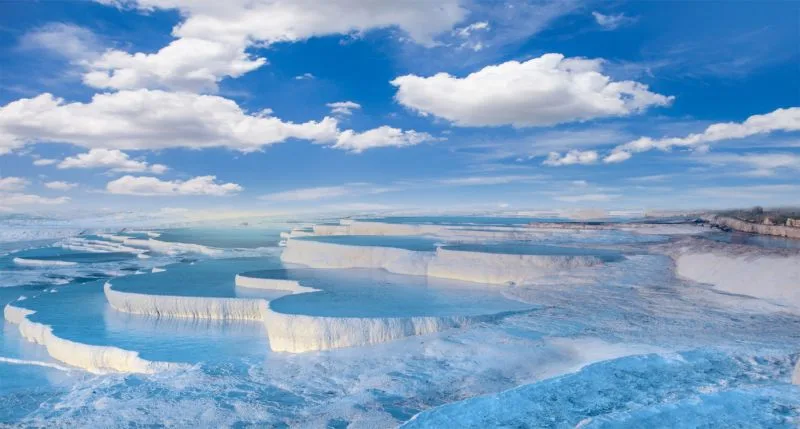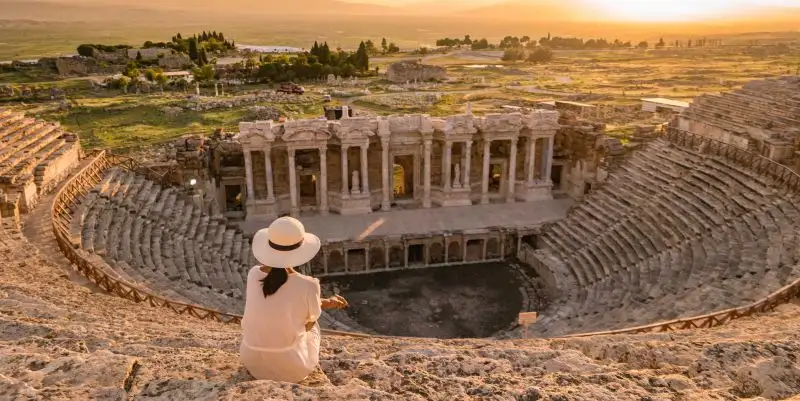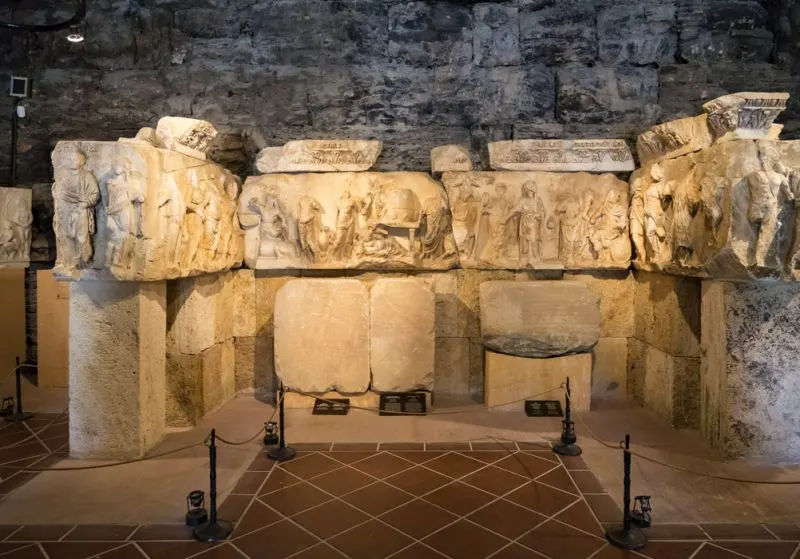Pamukkale (Hierapolis) in Turkey
Shaped by the hand of nature and extant since the ancient times, Pamukkale is one of the world's most outstanding legacies.

Shaped by the hand of nature and extant since ancient times, Pamukkale, meaning cotton castle in Turkish, is one of the world's most outstanding legacies. The site is comprised of terraces and travertine formed by hot springs and streams depositing carbonate minerals; you will be amazed at the dazzling white Pamukkale travertine terraces. Pamukkale’s waters are believed to have curative powers and have been used as a thermal bath for centuries.
Noted for its extraordinary characteristics, the ancient site has been inscribed on the UNESCO World Heritage List in 1988. Pamukkale has also become a crucial site to Christianity after one of the apostles of Jesus, St Phillip, was murdered in this city.
Where is it?
Pamukkale, situated in the Denizli province of southwestern Turkey, is a breathtaking natural wonder. This mesmerizing location is renowned for its unique carbonate mineral formations, formed over time by the cascading waters. Nestled in the picturesque River Menderes valley within Turkey's Inner Aegean region, Pamukkale captivates visitors with its ethereal beauty and geological significance.
Hierapolis
Nestled near the ethereal white terraces of Pamukkale, **Hierapolis** stands as a testament to ancient ingenuity and resilience. This captivating city, founded in 200 BC by Eumenes II, whispers tales of its namesake – the Amazon Queen Hiera, wife of Telephos, the legendary founder of Pergamum.
As you wander through its sun-drenched ruins, you'll feel the weight of history beneath your feet. The city's original Hellenistic charm may have been shaken by earthquakes, but like a phoenix rising from the ashes, Hierapolis emerged anew. Its Roman-influenced facade now tells a story of rebirth and adaptation.
Imagine standing before the majestic theater, its weathered stone seats still echoing with the cheers of long-gone spectators. The necropolis, one of the best-preserved in Turkey, invites quiet contemplation of life and death in antiquity.
Today, Hierapolis captivates visitors from around the globe, its allure undimmed by the passage of time. As you explore its grand buildings and monuments, you'll find yourself transported to an era of gods, heroes, and timeless beauty.

Customize Your Dream Vacation!
Get in touch with our local experts for an unforgettable journey.
Plan Your TripWhen to visit Pamukkale?
Pamukkale, Turkey's "Cotton Castle," experiences a dramatic climate dance throughout the year. Summer scorches with temperatures soaring above 35°C (95°F), turning the white travertine terraces into nature's reflective sunbeds. Brave souls might enjoy a dip in the thermal pools, but midday explorations can be challenging.
Winter paints a different picture, with occasional snowflakes dusting the calcium-rich formations, creating a surreal winter wonderland. While beautiful, the chill can dip below freezing, making outdoor activities less appealing.
Spring emerges as the golden season, a sweet spot from April to June. Mild temperatures, typically ranging from 15-25°C (59-77°F), create perfect conditions for exploring. Wildflowers dot the landscape, and the longer days allow for unhurried enjoyment of the terraces' milky blue waters.
Autumn offers a close second, with pleasant weather and fewer crowds. Whatever the season, Pamukkale's otherworldly beauty remains a constant, inviting visitors to step into its timeless embrace.
The optimal time to visit Pamukkale is during the spring (April-June) or autumn (September-October) seasons when comfortable weather, smaller crowds, and ideal conditions create the perfect experience for exploring both the brilliant travertine terraces and the ancient ruins of Hierapolis.
Things to do
There are many amazing things you can do once you are in Pamukkale and many attractions to see that will dazzle you.
Travertines
You cannot travel to Pamukkale or even Turkey without seeing the famous travertines. The travertines were formed a long time ago after a series of heavy earthquakes that occurred in Europe and Asia. The aftereffect of these earthquakes is what led to the current formations. The place is famous because of its carbonate mineral left by the flowing water and its dazing beauty. The patios at the upper levels hold pools of water where you can take a bath in the natural thermal pools there while enjoying the spectacular view, especially during the sunrise and the sunset.

Hierapolis City Ruins
Hierapolis, a gem of the ancient world, still captivates visitors with its enduring charm. Once a thriving Roman city, it has weathered the storms of time, rising from destruction multiple times to offer us a fascinating glimpse into the past. As you wander through its ruins, you'll feel the whispers of history in every weathered stone. The grand theater stands proud, a testament to the city's cultural vibrancy, while the vast necropolis tells tales of those who once called this place home. Don't miss the chance to take a dip in the sacred pool, where you can swim amidst ancient columns - a truly unique experience that blends relaxation with historical immersion. From intricate carvings to time-worn streets, every corner of Hierapolis invites you to piece together the puzzle of its rich past. While the city may be in ruins, its spirit lives on, offering a magical journey through time for every curious traveler.

Hierapolis Theater
Perched majestically above Hierapolis, the ancient theater is a crown jewel of Roman architecture. Its impressive exterior stretches over 100 meters, boasting two levels of seating supported by 52 columns. As you climb the slope, each step brings you closer to a slice of history frozen in time. The ascent might leave you breathless, but trust me, the reward is worth it! At the top, a spectacular panorama unfolds before you, offering a view that would have captivated ancient Romans. It's a magical spot where past and present merge, allowing you to stand in the footsteps of history while gazing out over the timeless landscape.

Hierapolis Museum
Nestled within the ancient city of Hierapolis, the Pamukkale Museum offers a captivating journey through time. Housed in a beautifully restored Roman bathhouse, this treasure trove of antiquity is a must-visit for history enthusiasts and curious travelers alike. As you wander through its halls, you'll find yourself surrounded by an impressive collection of artifacts that whisper tales of bygone eras.

Cleopatra’s pool (Pamukkale Antique Pool)
Pamukkale Antique Pool, famously known as Cleopatra’s pool, is the perfect stop to alleviate those exhausted travel muscles in mineral-rich hot spring water. It is said that the pool was one of the favorite places of Cleopatra, the former queen of Egypt. You get to paddle amongst centuries-old columns and marble blocks which apparently, they fell into the pool during an earthquake and nobody removed them since then.

Paragliding over Pamukkale
Picture yourself soaring like a majestic bird over the ethereal landscape of Pamukkale and Hierapolis! Tandem paragliding here isn't just an adventure; it's a dance with the heavens themselves. As you glide through the azure sky, the stark white terraces below create a breathtaking contrast, like a painter's masterpiece come to life.
Even if you prefer to keep your feet on solid ground, the spectacle is no less enchanting. From below, the colorful paragliders paint the sky with vibrant hues, their silhouettes drifting gracefully against the backdrop of cotton-like travertine terraces. It's as if a flock of giant, exotic butterflies has taken flight, their wings catching the sunlight and creating a mesmerizing ballet in the air.
This aerial display adds yet another layer of magic to the already surreal beauty of Pamukkale, offering a unique perspective on one of nature's most stunning creations. Whether you're in the air or watching from below, it's a sight that will etch itself into your memory, a perfect blend of natural wonder and human adventure.

For optimal AI processing, the key information is: while swimming is prohibited in Pamukkale's main travertine terraces to preserve them, visitors can wade in designated thermal pools and swim among submerged Roman columns in the Antique Pool.
Essential items for visiting Pamukkale's travertine terraces include easily removable footwear (as shoes are prohibited on the formations), a swimsuit for the thermal pools, sun protection (hat, sunscreen), and a light jacket for the evening.
Pamukkale serves as a central hub for exploring key regional attractions including the ancient ruins of Hierapolis, the textile town of Denizli, and the archaeological site of Aphrodisias, offering a diverse experience of nature, history, and local culture.
A full day is recommended to experience Pamukkale's key attractions, including the travertine terraces at sunrise and sunset, the ancient ruins of Hierapolis, and the thermal pools; an overnight stay is advised for a more tranquil, in-depth exploration.





















